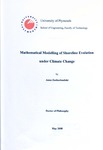Mathematical modelling of shoreline evolution under climate change
| dc.contributor.author | Zacharioudaki, Anna | |
| dc.contributor.other | Faculty of Science and Engineering | en_US |
| dc.date.accessioned | 2011-05-13T13:33:40Z | |
| dc.date.available | 2011-05-13T13:33:40Z | |
| dc.date.issued | 2008 | |
| dc.identifier | Not available | en_US |
| dc.identifier.uri | http://hdl.handle.net/10026.1/473 | |
| dc.description.abstract |
This study focuses on the impact of potential changes in the wind-wave climate on shoreline change. The `one-line' model for medium to long-term prediction of coastline evolution is employed. New analytical and numerical solutions of this important model are described. Specifically: 1) original semi-analytical solutions are derived that relax the unrealistic assumption of existing analytical work that a constant wave condition drives shoreline change and, 2) a more general form of the one-line model is solved with a novel application of the `Method of Lines'. Model input consists of 30-year nearshore wave climate scenarios, corresponding to the `present' (1961-1990) and the future (2071-2100). Winds from a high resolution, (12km x 12km), regional climate model, obtained offshore of the south-central coast of England at a dense temporal resolution of 3 hours, are used to develop the aforementioned wave climate scenarios, through hindcast and inshore wave transformation. A hypothetical shoreline segment is adopted as a `benchmark' case for comparisons. Monthly and seasonal statistics of output shoreline positions are generated and assessedfo r relative changeso f `significance' between `present' and future. Different degrees of evidence that such changes do exist are found. This study is the first application of such high resolution climate model output to investigate climate change impact on shoreline response. Major findings include: 1) shoreline changes of `significance' are strongly linked to `significant' changes in future wave direction, 2) future changes appear smaller for entire seasons than for individual months, 3) shoreline position variability is often smaller in the future, 4) different climate model experiments produce diverging results; however, general trends are largely similar. The present study, at a fundamental level, offers analytical solutions of the 'oneline' model that are closer to reality and a numerical solution that is of increased effciency.. At a practical level, it contributes to better understanding of the patterns of shoreline response to changing offshore wave climate through: 1) the use of fast and straightforward methods that can accommodate numerous climate scenarios without need for data reduction, and 2) the development of a methodology for using climate model output for coastal climate change impact assessment studies. | en_US |
| dc.language.iso | en | en_US |
| dc.publisher | University of Plymouth | en_US |
| dc.title | Mathematical modelling of shoreline evolution under climate change | en_US |
| dc.type | Thesis | |
| dc.identifier.doi | http://dx.doi.org/10.24382/3350 |
Files in this item
This item appears in the following Collection(s)
-
01 Research Theses Main Collection
Research Theses Main


